Each of us has heard at least once in our lives that nerve cells do not recover. But, after conducting a lot of serious research and experiments, scientists were able to prove that the human body is capable of not only “wasting”, but also “creating” new nerve cells. This process is called “neurogenesis”.
Since people only recently learned about neurogenesis, scientists do not yet have clear answers to questions related to this topic, and their opinions differ in many respects. And there is nothing strange or surprising in this, because studying the human brain is difficult for both medical and ethical reasons.
While scientists continue to conduct research on rodents, in this article we will try to sort out all the information about the formation of new neural connections in the brain that is currently available to us.
Some useful information about neurons
Neurons, unlike all other cells in our body, “do not know how” to divide, so until recently scientists were convinced that a person lives his entire life with the limited supply of nerve cells that he received at birth. The results of numerous modern studies have shown that this statement is not true, since neurons are still created throughout our lives. This happens thanks to stem cells, which have the ability to transform into cells of almost any type.
Our brain has its own supply of stem cells. Scientists cannot yet determine the exact number of departments involved in the formation of new nerve cells. What the scientific community knows is that new neurons are formed in the dentate gyrus of the hippocampus, which is responsible for memory and emotion, and a thin layer of cells located along the ventricles of the brain (subventicular zone).
Many newly formed neurons die almost immediately due to the active work of neurotransmitters, the negative influence of the microenvironment, certain proteins and other chemistry occurring in our brain.
In order for a newly formed nerve cell to continue to exist, it needs to form a neural connection (synapse) with other nerve cells. Since the brain does not need lonely floating neurons at all, it simply destroys them, because they do not bring it any benefit and will not be able to bring it in the future. The same neurons that were able to establish connections with other nerve cells are successfully integrated into the structure of our brain.
Every day, about 700-800 neurons can be integrated into the structure of the brain, which managed to survive and form new neural connections.
Brain-programmed cell death, or apoptosis, is a completely normal process that should not be feared. With the help of apoptosis, the brain restores order and gets rid of unnecessary neurons.
The average adult brain consists of approximately 85-88 million nerve cells.
The brain of a newborn contains many more neurons, but by the end of the first year of life their number is almost halved. Psychophysiologist and employee of the Psychological Institute of the Russian Academy of Education Ilya Zakharov explains this by the fact that the human brain develops most actively in the first three years after birth.
Why is this happening? The fact is that it is during this period of time that the child actively explores the world around him: he constantly touches something new, smells it, sees it, tastes it or touches it, etc. All new knowledge is recorded in the baby’s brain in the form of new neural connections, thanks to which all formed and already consolidated skills, all acquired emotional and intellectual experience are preserved.
Although the human brain develops in this way throughout life, it makes its “main breakthrough” in early childhood.
How do neural connections influence our perception of the world around us?
Any person, regardless of the level of his spiritual development, is driven by one of three basic instincts: the instinct of reproduction, the instinct of hierarchy and the instinct of survival. They, deeply “sitting” somewhere in the depths of our reptilian brain, clearly and prudently control our lives. It is thanks to instincts that we want to win the recognition and respect of the people around us, stand out from the crowd, love and be loved, give birth and raise children, move forward and solve not only life, but also mathematical or economic problems. Instincts greatly influence our choices and our daily lives.
In animals, the reptilian brain and the limbic system, responsible for the production of “happiness hormones,” are responsible for satisfying the desires caused by the three basic instincts. In our arsenal we have a well-developed cerebral cortex, which gives us the ability to satisfy instinctual desires in millions of different ways. A well-developed cortex allows us not only to realize our instincts, but also to deceive the brain, pretending that, while satisfying instinctual desires, we are actually choosing the right, constructive and useful way.
Why should we engage in self-deception? And then, that the brain, in both the first and second cases, “hands” us a “gift” in the form of a hormonal “bun”.
The essence of this issue lies precisely in the self-deception of our brain: when our brain performs an objectively harmful action, it is internally convinced that this action actually contributes to our survival. The brain perceives an objectively useful action as a threat to survival, so it is often accompanied by stress.
Previously formed neural connections include all our skills, habits and associations. And there is nothing wrong with this, but the whole problem is that most often these connections are created completely by accident, and then these randomly formed neural paths lead us in the wrong direction and become a serious obstacle to our happiness.
✔ If parents constantly praise a child for being good at math, powerful neural pathways are formed in his brain, created by the positive effects of dopamine and serotonin. In this case, mathematics becomes a source of true pleasure for such a child, so he will constantly develop in this direction, and in adulthood he will be able to achieve some significant results and achieve success.
✘ If the parents never encouraged the child and all his endeavors were accompanied by harsh comments, then this neural connection will be “polished” by the negative influence of the hormone cortisol. Over time, the child will hate mathematics, will not want to develop in this direction and will choose a completely different type of activity. As an adult, he may not remember where such a dislike for the exact sciences came from.
This scheme can be applied not only to the choice of activity, but also to people, places, films, books, music, etc. The stronger the hormone release (accompanying emotion), the stronger and faster the neural connection is formed.
Therefore, each of us can at any moment find ourselves as Alice through the looking glass and begin to have a positive attitude towards what is harmful, and will shy away from what is useful. With the help of harmful and excessive pleasures, our brain tries to avoid long-past negativity. Therefore, as an adult, you will avoid mathematics because your parents were negative about your hobby, or you will become addicted to sweets because cakes as a child helped you survive another failure, etc.
The formation of neural connections is influenced not only by hormones and the emotions they cause, but also by the number of repetitions. The more often and regularly you repeat an action, the stronger the neural connection becomes.
If a neural connection leads to an objectively negative result (scandal, physical violence, job loss, obesity, health problems, etc.), and it is not only strong enough, but also “polished” by positive hormones and pleasant emotions, then the human brain will subjectively perceive such a neural connection as necessary and useful.
Neural connections formed through strong emotions and a lot of repetition can lead us to both the Garden of Eden and the gates of hell. And all this happens without any effort on the part of our conscious mind.
What does neuroplasticity depend on?
- From the condition of the blood vessels. The more active the blood supply to the brain, the better the neurons work.
- From age. Still, neuroplasticity is higher in young people than in older people.
- From training. The more often we repeat a certain action, the more intensively and methodically we strive to learn, the higher the likelihood that neurons will cooperate to perform that action.
- From the start of training. After an injury or stroke, it is better to start training as early as possible, since otherwise the brain has time to adapt to what is happening (it stops taking into account the damaged functions), and it becomes more difficult to activate them over time.
- From the variety of practice. The more often we use neuroplasticity, the higher it is. When learning a specific skill, the learning ability of our brain in general increases.
How to create new neural connections in the brain: several effective ways
When choosing between familiar and new behavior, most people will give preference to the first option. Why? From many men and women you can hear the following phrase: “In my mind I understand everything, but I can’t help myself. I tell myself that the current situation does not suit me at all, but I continue to behave as I did before!” Paradox? No! It's all about the already formed neural connections!
The stronger the neural connection, the more synapses are formed (a synapse is the point of contact between two nerve cells), and the more powerful and effective the electrical signals between the nerve cells included in this connection become. The more synapses are formed, the more active and efficient they begin to work. Nerve cells that are part of a strong neural connection are eventually covered with a specific sheath, which can be compared to wires. It not only protects and insulates neurons, but also significantly increases their activity.
This is why a person who does not act as usual feels dissatisfaction and anxiety on both a mental and physical level. When you refuse to follow the neural pathways that have already been formed, your brain perceives this as a threat to your survival.
But these old neural connections are rooted in your head only because your brain once associated them with “happiness hormones” and positive emotions! By repeating this or that action that evokes a positive emotion a certain number of times, you “forced” your brain to “believe” that it is directly related to your survival.
Is it possible to get rid of old, objectively harmful and leading to nowhere neural connections? Is it possible to create new neural connections that will change your life for the better? Not only is it possible, but it is necessary! How to do it? We bring to your attention several effective ways!
Changing our usual lifestyle
Scientists have proven that those processes that harm the body also negatively affect the brain. Chronic overwork, constant stress, lack of sleep, nightmares, depression, constant overeating, abuse of drugs and alcoholic beverages, bad habits, sedentary lifestyle, unbalanced diet and many other negative environmental factors prevent the formation of new neural connections.
Studies conducted on mice have shown that the formation of new nerve cells and their connections is promoted by physical activity, a diet enriched with nutrients, a good night's rest, various entertainment, etc.
In people leading a healthy and active lifestyle, the brain, compared to people leading an inactive and sedentary lifestyle, ages much more slowly.
Replacing the old neural connection with a completely new one
To learn how to build new neural connections based on old ones, you need to connect the desired behavior with the behavior that your brain is used to that gives you pleasure. Let's consider this method of creating useful neural connections using the example of a person who needs to find a new job.
A person who needs to find an honest and fair employer understands perfectly well that this undertaking is quite difficult and will have to spend a lot of personal time on it, so he does everything possible to delay the moment of starting the search. To make the task easier, such a person needs to associate the job search process with something that evokes positive emotions in him. If a specialist who wants to find a job loves green tea, then he needs to go to his favorite cafe along with his tablet or laptop, order green tea there and begin for a certain time (1.5-2 hours) to monitor those sites on which he can find someone suitable for him employer.
It will be difficult at first, but after 5-7 days it will become much easier for such a person to search for a job. And if the process goes the right way and the body begins to produce dopamine, then those who want to find a job will come to their favorite cafe 10 minutes before it opens, just to quickly order green tea and continue their search!
If you have been planning to start playing sports for a long time and have already signed up for a gym, then you should combine training with what you love and what gives you positive emotions: listen to your favorite music, buy new sportswear that you have been eyeing for a long time, but If you still can’t buy it, sign up for a massage and go to the session immediately after training, invite a colleague or friend with you, etc.
This method may seem trivial to many people, but this is how you can build a completely new and objectively useful neural connection based on an old and objectively harmful neural connection.
Connecting old neural pathways with new ones, and unpleasant things with pleasant ones, is a rather labor-intensive task. The older a person gets, the more difficult it is for his brain to create new synapses between nerve cells. Therefore, the involvement of already existing connections (patterns) in the creation of completely new neural pathways greatly simplifies this task.
We find a pleasant and useful replacement
When we are deprived of something familiar, we begin to experience severe discomfort and a depressing feeling of anxiety. The brain, trying to avoid these destructive sensations, “pushes” us to do something in the literal sense of the word. Most often, people start doing all sorts of unnecessary things that not only do not change their lives for the better, but can also cause serious problems with mental or physical health in the future. This is why many former smokers replace cigarettes with food and gain excess weight very quickly. Many of them understand perfectly well that this is impossible, but they cannot help themselves, because food not only saves them from anxiety and discomfort, but also activates the production of “happiness hormones.”
This is why you need to find a pleasant and healthy replacement. Some people prefer reading books, some are attracted to drawing, some join the gym, and some devote themselves entirely to work. Each of us has our own individual preferences, so a universal replacement that would suit absolutely any person does not exist and cannot exist!
When looking for a pleasant and useful replacement, do not forget that your priority should be the goal (creating useful neural connections), and not the means you use to achieve it.
If a person comes to his favorite cafe, orders green tea several times, but monitors social networks and corresponds with a friend, and does not look for a job, then the means that he chose to achieve his goal are completely unsuitable for him! If you have “chosen” a certain neural connection and influence it in one way or another, but “things are still there,” then you should continue to search for funds until you find the options that suit you!
If you watched the animated series “Hey Arnold,” you must remember Chocolate Boy, who could not live a day without chocolate. Arnold, having learned the sad story of his new friend, did everything possible to help him. A chocolate-loving schoolboy was able to get rid of his chocolate addiction, but became addicted to radishes. Radishes, unlike chocolate, are good for the body, so Chocolate Boy not only created a new neural connection in his head with the help of a replacement, but also improved the quality of his life!
Learning to overcome feelings of rejection
Why don’t we rush to get to know those people who are unpleasant to us, listen to the music of unknown performers, read books by an unknown author or watch a film by an unknown director? The fact is that our brain tends to trust first impressions, so a person who wants to create a new neural connection sometimes needs to do something that he does not like at all.
Many of our sensations are often based only on some random life experience, so they are not always able to objectively reflect the entire situation. Such randomly formed neural connections cause us to experience a feeling of rejection and anxiety every time we “deviate” from a well-known path and perform an action that is unusual for us.
If you give preference to old neural connections only because you do not want to experience feelings of rejection and anxiety, then you are missing out on a huge number of opportunities to change your life for the better and become a truly happy person.
We regularly and “even if we don’t want to” repeat the desired action.
To create the necessary synaptic connections between nerve cells, it is necessary to repeat the same action over and over again. And it doesn’t matter whether “happiness hormones” are released at this moment or not. Repeated repetition helps create a new neural connection without the active participation of emotions.
If you systematically perform the same action and repeat the same behavior, then in one or another neural connection the transmission of electrical signals becomes more and more efficient each time, and the connection with the production of “happiness hormones” becomes stronger. The same neurons that remain in an inactive state for a long time are destroyed by the brain, since it no longer needs them. This is how the economy and flexibility of our nature manifests itself!
It is necessary to spend from several days to several months to train the brain to associate a useful and necessary action with “happiness hormones”. To do this, you need to actively engage the prefrontal cortex, which is responsible for self-control.
At first, you will prefer the old behavior, because new actions will make you feel discomfort, anxiety, rejection and restlessness. If you perform the action you need regularly and “even if you don’t want to,” you can create a new neural connection in your brain, thanks to which your life will begin to change for the better!
We draw up a special summary
Many theoretical physics students who want to create new neural connections in their brain use this method. To make an outline, you need to take some text and read it twice: the first time - fluently, and the second time - very thoughtfully.
Using the original freely, rewrite the text verbatim, and then reread what you wrote. Set aside both the original and the rewritten text. Take a blank sheet of paper and summarize all the information obtained from the original. Read your resume and try to write the entire text yourself without using any prompts.
Using this method, you will not only “force” your brain to create new neural connections by reading, reproducing, memorizing and structuring, but also, by stimulating the nerve endings on your fingers, you will have a positive effect on your own mnemonic abilities.
Our channel: Yandex Zen
Exercises to improve neuroplasticity
All these exercises are related to inviting your brain to do things that are familiar to it in an unusual way and to collect “other teams” of neurons for this. By training the brain to perform unusual actions, we keep it in good shape and improve learning ability.
- Use your non-dominant hand
For starters, you can try brushing your teeth or eating with your other hand. As you get more comfortable with this, switch back to your dominant hand.
- Turn off vision
Try eating, showering, and doing other usual things with your eyes closed (just be careful).
- Change small habits
Find ten new ways to get to work. Have lunch in a different place in your apartment than you usually do.
- See the world upside down
You can do this by looking “under your knees,” as children do, or by turning over familiar objects and looking at them from a different angle.
According to some studies, regular meditation and exercise can also improve neuroplasticity.











